Critical Analysis: Polypharmacy, Adherence, and Nursing Role in Care
VerifiedAdded on 2023/04/20
|15
|5017
|179
Case Study
AI Summary
This case study critically analyzes the polypharmacy and medication adherence issues of Connie Cooper, an 83-year-old breast cancer patient with bone metastasis. The analysis encompasses pharmacological processes (pharmacokinetics, pharmacodynamics, drug interactions of medications like fentanyl, paracetamol, naproxen, fluoxetine, furosemide, simvastatin, aspirin, gaviscon, tamoxifen, zopiclone, senna, ramipril and St. John’s Wort), medicines management, nursing care, and safe practices. It emphasizes the nurse's role in ensuring medication safety, patient education, and adherence to treatment plans, considering the complexities of managing multiple medications in an elderly patient with several comorbidities. The essay highlights the importance of understanding drug mechanisms, potential side effects, and interactions to optimize patient outcomes and minimize adverse events.
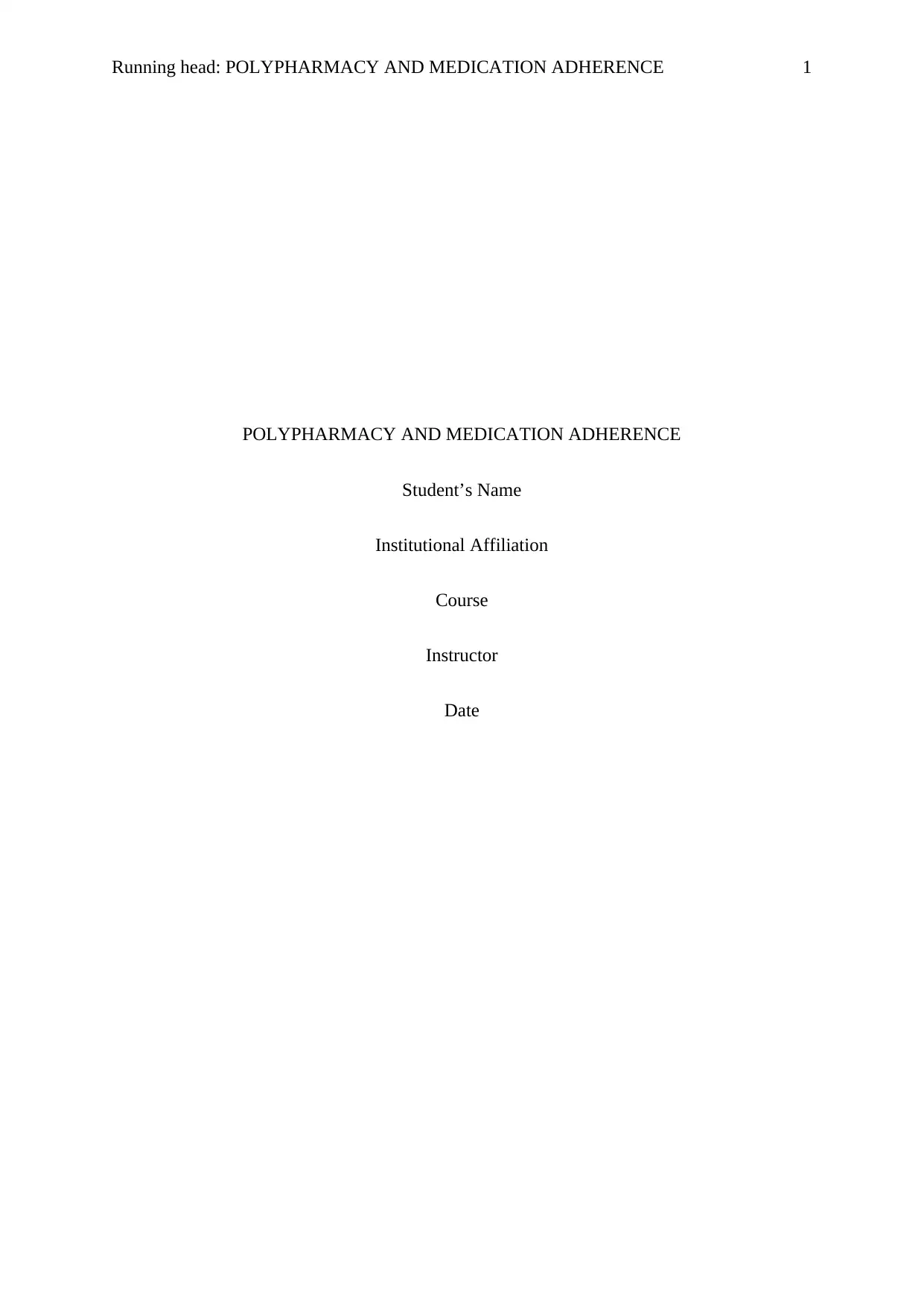
Running head: POLYPHARMACY AND MEDICATION ADHERENCE 1
POLYPHARMACY AND MEDICATION ADHERENCE
Student’s Name
Institutional Affiliation
Course
Instructor
Date
POLYPHARMACY AND MEDICATION ADHERENCE
Student’s Name
Institutional Affiliation
Course
Instructor
Date
Paraphrase This Document
Need a fresh take? Get an instant paraphrase of this document with our AI Paraphraser
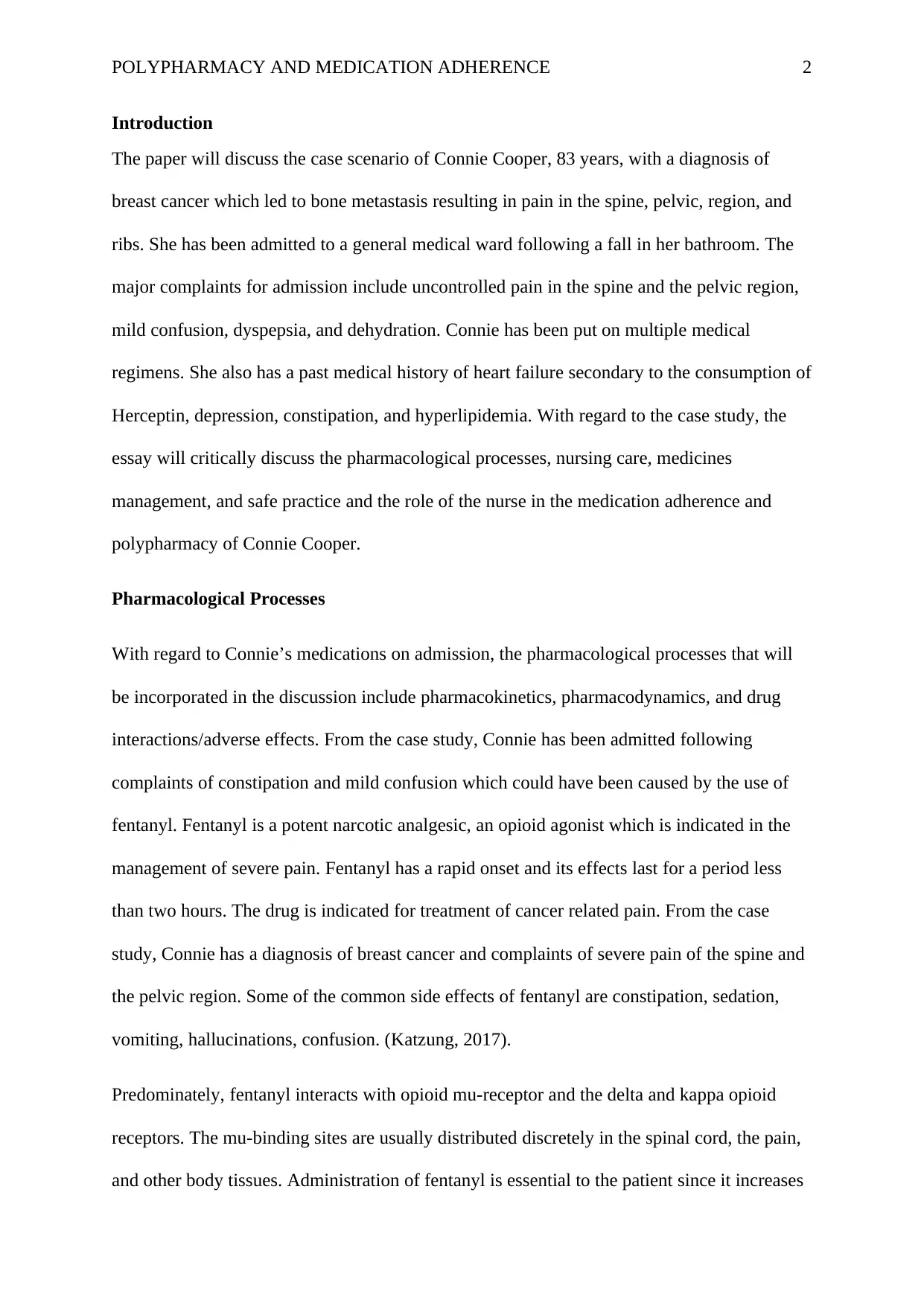
POLYPHARMACY AND MEDICATION ADHERENCE 2
Introduction
The paper will discuss the case scenario of Connie Cooper, 83 years, with a diagnosis of
breast cancer which led to bone metastasis resulting in pain in the spine, pelvic, region, and
ribs. She has been admitted to a general medical ward following a fall in her bathroom. The
major complaints for admission include uncontrolled pain in the spine and the pelvic region,
mild confusion, dyspepsia, and dehydration. Connie has been put on multiple medical
regimens. She also has a past medical history of heart failure secondary to the consumption of
Herceptin, depression, constipation, and hyperlipidemia. With regard to the case study, the
essay will critically discuss the pharmacological processes, nursing care, medicines
management, and safe practice and the role of the nurse in the medication adherence and
polypharmacy of Connie Cooper.
Pharmacological Processes
With regard to Connie’s medications on admission, the pharmacological processes that will
be incorporated in the discussion include pharmacokinetics, pharmacodynamics, and drug
interactions/adverse effects. From the case study, Connie has been admitted following
complaints of constipation and mild confusion which could have been caused by the use of
fentanyl. Fentanyl is a potent narcotic analgesic, an opioid agonist which is indicated in the
management of severe pain. Fentanyl has a rapid onset and its effects last for a period less
than two hours. The drug is indicated for treatment of cancer related pain. From the case
study, Connie has a diagnosis of breast cancer and complaints of severe pain of the spine and
the pelvic region. Some of the common side effects of fentanyl are constipation, sedation,
vomiting, hallucinations, confusion. (Katzung, 2017).
Predominately, fentanyl interacts with opioid mu-receptor and the delta and kappa opioid
receptors. The mu-binding sites are usually distributed discretely in the spinal cord, the pain,
and other body tissues. Administration of fentanyl is essential to the patient since it increases
Introduction
The paper will discuss the case scenario of Connie Cooper, 83 years, with a diagnosis of
breast cancer which led to bone metastasis resulting in pain in the spine, pelvic, region, and
ribs. She has been admitted to a general medical ward following a fall in her bathroom. The
major complaints for admission include uncontrolled pain in the spine and the pelvic region,
mild confusion, dyspepsia, and dehydration. Connie has been put on multiple medical
regimens. She also has a past medical history of heart failure secondary to the consumption of
Herceptin, depression, constipation, and hyperlipidemia. With regard to the case study, the
essay will critically discuss the pharmacological processes, nursing care, medicines
management, and safe practice and the role of the nurse in the medication adherence and
polypharmacy of Connie Cooper.
Pharmacological Processes
With regard to Connie’s medications on admission, the pharmacological processes that will
be incorporated in the discussion include pharmacokinetics, pharmacodynamics, and drug
interactions/adverse effects. From the case study, Connie has been admitted following
complaints of constipation and mild confusion which could have been caused by the use of
fentanyl. Fentanyl is a potent narcotic analgesic, an opioid agonist which is indicated in the
management of severe pain. Fentanyl has a rapid onset and its effects last for a period less
than two hours. The drug is indicated for treatment of cancer related pain. From the case
study, Connie has a diagnosis of breast cancer and complaints of severe pain of the spine and
the pelvic region. Some of the common side effects of fentanyl are constipation, sedation,
vomiting, hallucinations, confusion. (Katzung, 2017).
Predominately, fentanyl interacts with opioid mu-receptor and the delta and kappa opioid
receptors. The mu-binding sites are usually distributed discretely in the spinal cord, the pain,
and other body tissues. Administration of fentanyl is essential to the patient since it increases
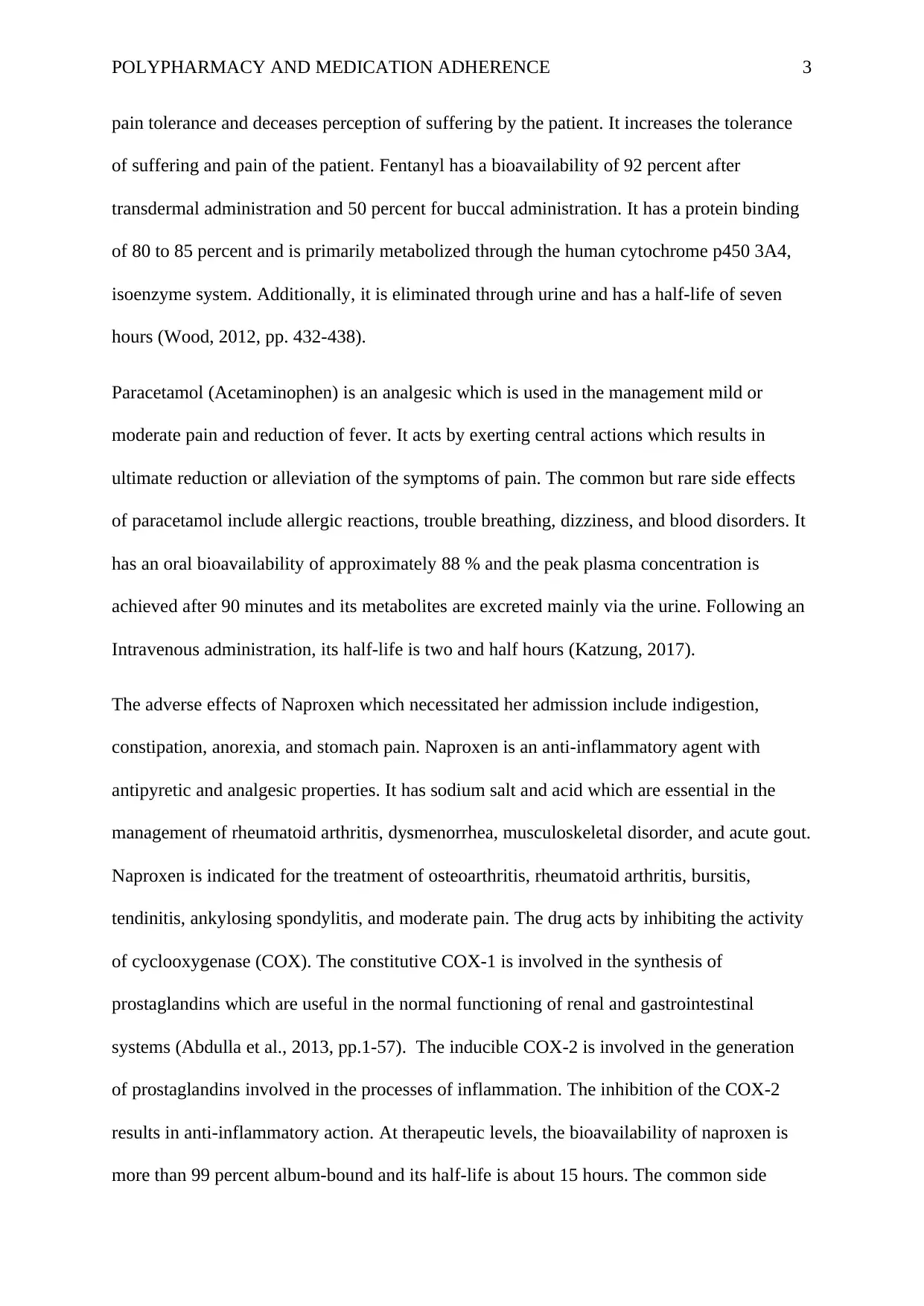
POLYPHARMACY AND MEDICATION ADHERENCE 3
pain tolerance and deceases perception of suffering by the patient. It increases the tolerance
of suffering and pain of the patient. Fentanyl has a bioavailability of 92 percent after
transdermal administration and 50 percent for buccal administration. It has a protein binding
of 80 to 85 percent and is primarily metabolized through the human cytochrome p450 3A4,
isoenzyme system. Additionally, it is eliminated through urine and has a half-life of seven
hours (Wood, 2012, pp. 432-438).
Paracetamol (Acetaminophen) is an analgesic which is used in the management mild or
moderate pain and reduction of fever. It acts by exerting central actions which results in
ultimate reduction or alleviation of the symptoms of pain. The common but rare side effects
of paracetamol include allergic reactions, trouble breathing, dizziness, and blood disorders. It
has an oral bioavailability of approximately 88 % and the peak plasma concentration is
achieved after 90 minutes and its metabolites are excreted mainly via the urine. Following an
Intravenous administration, its half-life is two and half hours (Katzung, 2017).
The adverse effects of Naproxen which necessitated her admission include indigestion,
constipation, anorexia, and stomach pain. Naproxen is an anti-inflammatory agent with
antipyretic and analgesic properties. It has sodium salt and acid which are essential in the
management of rheumatoid arthritis, dysmenorrhea, musculoskeletal disorder, and acute gout.
Naproxen is indicated for the treatment of osteoarthritis, rheumatoid arthritis, bursitis,
tendinitis, ankylosing spondylitis, and moderate pain. The drug acts by inhibiting the activity
of cyclooxygenase (COX). The constitutive COX-1 is involved in the synthesis of
prostaglandins which are useful in the normal functioning of renal and gastrointestinal
systems (Abdulla et al., 2013, pp.1-57). The inducible COX-2 is involved in the generation
of prostaglandins involved in the processes of inflammation. The inhibition of the COX-2
results in anti-inflammatory action. At therapeutic levels, the bioavailability of naproxen is
more than 99 percent album-bound and its half-life is about 15 hours. The common side
pain tolerance and deceases perception of suffering by the patient. It increases the tolerance
of suffering and pain of the patient. Fentanyl has a bioavailability of 92 percent after
transdermal administration and 50 percent for buccal administration. It has a protein binding
of 80 to 85 percent and is primarily metabolized through the human cytochrome p450 3A4,
isoenzyme system. Additionally, it is eliminated through urine and has a half-life of seven
hours (Wood, 2012, pp. 432-438).
Paracetamol (Acetaminophen) is an analgesic which is used in the management mild or
moderate pain and reduction of fever. It acts by exerting central actions which results in
ultimate reduction or alleviation of the symptoms of pain. The common but rare side effects
of paracetamol include allergic reactions, trouble breathing, dizziness, and blood disorders. It
has an oral bioavailability of approximately 88 % and the peak plasma concentration is
achieved after 90 minutes and its metabolites are excreted mainly via the urine. Following an
Intravenous administration, its half-life is two and half hours (Katzung, 2017).
The adverse effects of Naproxen which necessitated her admission include indigestion,
constipation, anorexia, and stomach pain. Naproxen is an anti-inflammatory agent with
antipyretic and analgesic properties. It has sodium salt and acid which are essential in the
management of rheumatoid arthritis, dysmenorrhea, musculoskeletal disorder, and acute gout.
Naproxen is indicated for the treatment of osteoarthritis, rheumatoid arthritis, bursitis,
tendinitis, ankylosing spondylitis, and moderate pain. The drug acts by inhibiting the activity
of cyclooxygenase (COX). The constitutive COX-1 is involved in the synthesis of
prostaglandins which are useful in the normal functioning of renal and gastrointestinal
systems (Abdulla et al., 2013, pp.1-57). The inducible COX-2 is involved in the generation
of prostaglandins involved in the processes of inflammation. The inhibition of the COX-2
results in anti-inflammatory action. At therapeutic levels, the bioavailability of naproxen is
more than 99 percent album-bound and its half-life is about 15 hours. The common side
⊘ This is a preview!⊘
Do you want full access?
Subscribe today to unlock all pages.

Trusted by 1+ million students worldwide
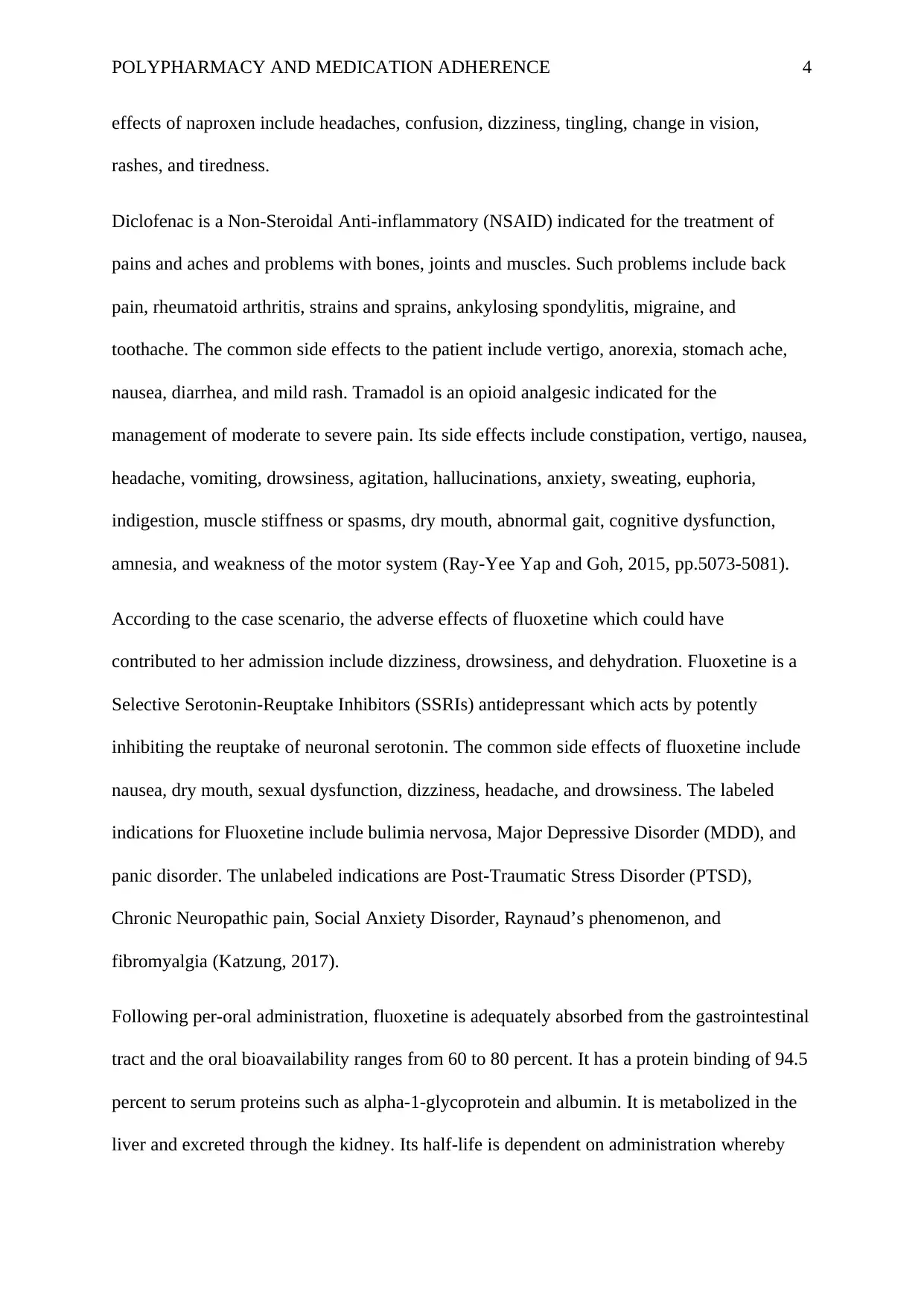
POLYPHARMACY AND MEDICATION ADHERENCE 4
effects of naproxen include headaches, confusion, dizziness, tingling, change in vision,
rashes, and tiredness.
Diclofenac is a Non-Steroidal Anti-inflammatory (NSAID) indicated for the treatment of
pains and aches and problems with bones, joints and muscles. Such problems include back
pain, rheumatoid arthritis, strains and sprains, ankylosing spondylitis, migraine, and
toothache. The common side effects to the patient include vertigo, anorexia, stomach ache,
nausea, diarrhea, and mild rash. Tramadol is an opioid analgesic indicated for the
management of moderate to severe pain. Its side effects include constipation, vertigo, nausea,
headache, vomiting, drowsiness, agitation, hallucinations, anxiety, sweating, euphoria,
indigestion, muscle stiffness or spasms, dry mouth, abnormal gait, cognitive dysfunction,
amnesia, and weakness of the motor system (Ray-Yee Yap and Goh, 2015, pp.5073-5081).
According to the case scenario, the adverse effects of fluoxetine which could have
contributed to her admission include dizziness, drowsiness, and dehydration. Fluoxetine is a
Selective Serotonin-Reuptake Inhibitors (SSRIs) antidepressant which acts by potently
inhibiting the reuptake of neuronal serotonin. The common side effects of fluoxetine include
nausea, dry mouth, sexual dysfunction, dizziness, headache, and drowsiness. The labeled
indications for Fluoxetine include bulimia nervosa, Major Depressive Disorder (MDD), and
panic disorder. The unlabeled indications are Post-Traumatic Stress Disorder (PTSD),
Chronic Neuropathic pain, Social Anxiety Disorder, Raynaud’s phenomenon, and
fibromyalgia (Katzung, 2017).
Following per-oral administration, fluoxetine is adequately absorbed from the gastrointestinal
tract and the oral bioavailability ranges from 60 to 80 percent. It has a protein binding of 94.5
percent to serum proteins such as alpha-1-glycoprotein and albumin. It is metabolized in the
liver and excreted through the kidney. Its half-life is dependent on administration whereby
effects of naproxen include headaches, confusion, dizziness, tingling, change in vision,
rashes, and tiredness.
Diclofenac is a Non-Steroidal Anti-inflammatory (NSAID) indicated for the treatment of
pains and aches and problems with bones, joints and muscles. Such problems include back
pain, rheumatoid arthritis, strains and sprains, ankylosing spondylitis, migraine, and
toothache. The common side effects to the patient include vertigo, anorexia, stomach ache,
nausea, diarrhea, and mild rash. Tramadol is an opioid analgesic indicated for the
management of moderate to severe pain. Its side effects include constipation, vertigo, nausea,
headache, vomiting, drowsiness, agitation, hallucinations, anxiety, sweating, euphoria,
indigestion, muscle stiffness or spasms, dry mouth, abnormal gait, cognitive dysfunction,
amnesia, and weakness of the motor system (Ray-Yee Yap and Goh, 2015, pp.5073-5081).
According to the case scenario, the adverse effects of fluoxetine which could have
contributed to her admission include dizziness, drowsiness, and dehydration. Fluoxetine is a
Selective Serotonin-Reuptake Inhibitors (SSRIs) antidepressant which acts by potently
inhibiting the reuptake of neuronal serotonin. The common side effects of fluoxetine include
nausea, dry mouth, sexual dysfunction, dizziness, headache, and drowsiness. The labeled
indications for Fluoxetine include bulimia nervosa, Major Depressive Disorder (MDD), and
panic disorder. The unlabeled indications are Post-Traumatic Stress Disorder (PTSD),
Chronic Neuropathic pain, Social Anxiety Disorder, Raynaud’s phenomenon, and
fibromyalgia (Katzung, 2017).
Following per-oral administration, fluoxetine is adequately absorbed from the gastrointestinal
tract and the oral bioavailability ranges from 60 to 80 percent. It has a protein binding of 94.5
percent to serum proteins such as alpha-1-glycoprotein and albumin. It is metabolized in the
liver and excreted through the kidney. Its half-life is dependent on administration whereby
Paraphrase This Document
Need a fresh take? Get an instant paraphrase of this document with our AI Paraphraser
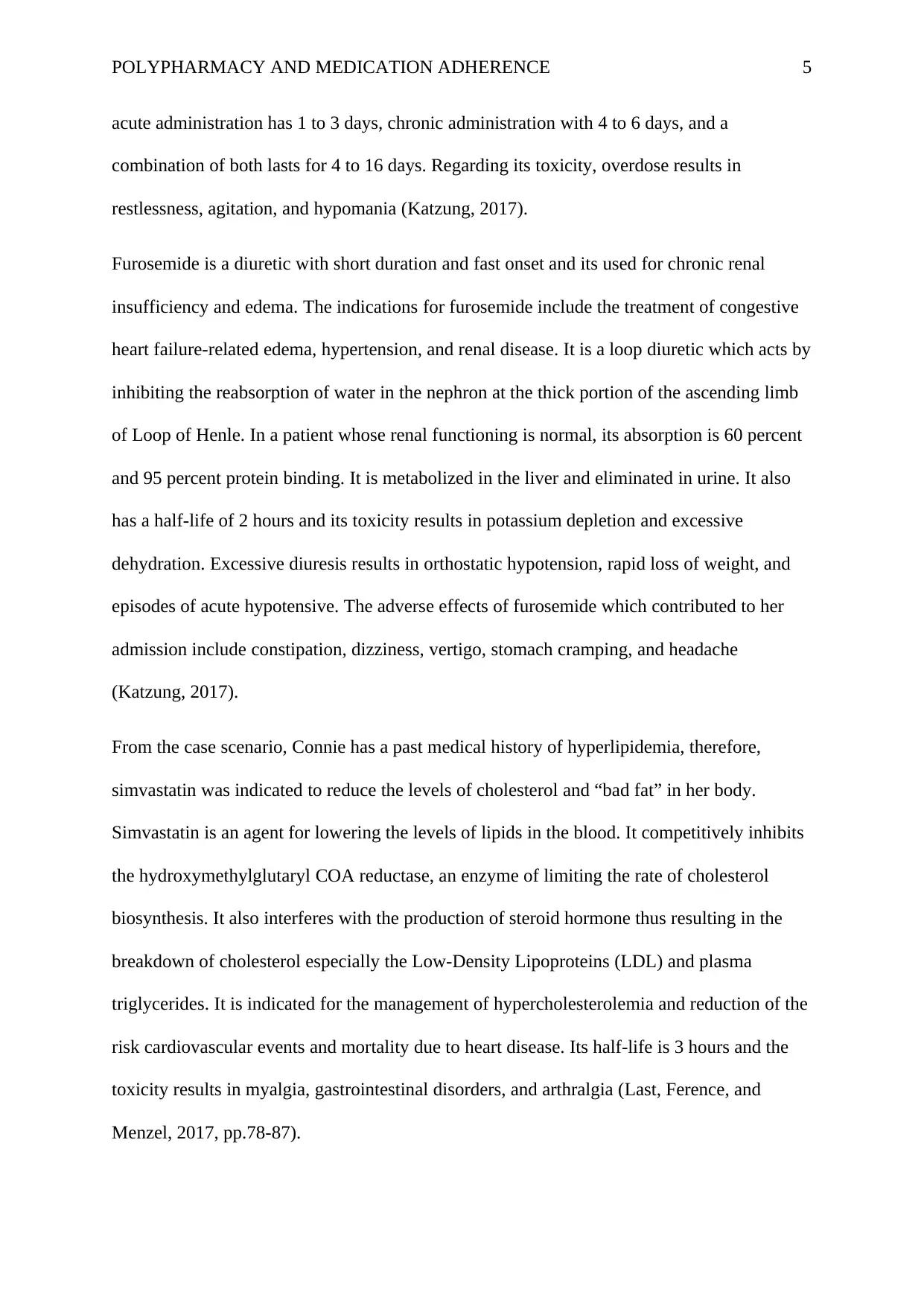
POLYPHARMACY AND MEDICATION ADHERENCE 5
acute administration has 1 to 3 days, chronic administration with 4 to 6 days, and a
combination of both lasts for 4 to 16 days. Regarding its toxicity, overdose results in
restlessness, agitation, and hypomania (Katzung, 2017).
Furosemide is a diuretic with short duration and fast onset and its used for chronic renal
insufficiency and edema. The indications for furosemide include the treatment of congestive
heart failure-related edema, hypertension, and renal disease. It is a loop diuretic which acts by
inhibiting the reabsorption of water in the nephron at the thick portion of the ascending limb
of Loop of Henle. In a patient whose renal functioning is normal, its absorption is 60 percent
and 95 percent protein binding. It is metabolized in the liver and eliminated in urine. It also
has a half-life of 2 hours and its toxicity results in potassium depletion and excessive
dehydration. Excessive diuresis results in orthostatic hypotension, rapid loss of weight, and
episodes of acute hypotensive. The adverse effects of furosemide which contributed to her
admission include constipation, dizziness, vertigo, stomach cramping, and headache
(Katzung, 2017).
From the case scenario, Connie has a past medical history of hyperlipidemia, therefore,
simvastatin was indicated to reduce the levels of cholesterol and “bad fat” in her body.
Simvastatin is an agent for lowering the levels of lipids in the blood. It competitively inhibits
the hydroxymethylglutaryl COA reductase, an enzyme of limiting the rate of cholesterol
biosynthesis. It also interferes with the production of steroid hormone thus resulting in the
breakdown of cholesterol especially the Low-Density Lipoproteins (LDL) and plasma
triglycerides. It is indicated for the management of hypercholesterolemia and reduction of the
risk cardiovascular events and mortality due to heart disease. Its half-life is 3 hours and the
toxicity results in myalgia, gastrointestinal disorders, and arthralgia (Last, Ference, and
Menzel, 2017, pp.78-87).
acute administration has 1 to 3 days, chronic administration with 4 to 6 days, and a
combination of both lasts for 4 to 16 days. Regarding its toxicity, overdose results in
restlessness, agitation, and hypomania (Katzung, 2017).
Furosemide is a diuretic with short duration and fast onset and its used for chronic renal
insufficiency and edema. The indications for furosemide include the treatment of congestive
heart failure-related edema, hypertension, and renal disease. It is a loop diuretic which acts by
inhibiting the reabsorption of water in the nephron at the thick portion of the ascending limb
of Loop of Henle. In a patient whose renal functioning is normal, its absorption is 60 percent
and 95 percent protein binding. It is metabolized in the liver and eliminated in urine. It also
has a half-life of 2 hours and its toxicity results in potassium depletion and excessive
dehydration. Excessive diuresis results in orthostatic hypotension, rapid loss of weight, and
episodes of acute hypotensive. The adverse effects of furosemide which contributed to her
admission include constipation, dizziness, vertigo, stomach cramping, and headache
(Katzung, 2017).
From the case scenario, Connie has a past medical history of hyperlipidemia, therefore,
simvastatin was indicated to reduce the levels of cholesterol and “bad fat” in her body.
Simvastatin is an agent for lowering the levels of lipids in the blood. It competitively inhibits
the hydroxymethylglutaryl COA reductase, an enzyme of limiting the rate of cholesterol
biosynthesis. It also interferes with the production of steroid hormone thus resulting in the
breakdown of cholesterol especially the Low-Density Lipoproteins (LDL) and plasma
triglycerides. It is indicated for the management of hypercholesterolemia and reduction of the
risk cardiovascular events and mortality due to heart disease. Its half-life is 3 hours and the
toxicity results in myalgia, gastrointestinal disorders, and arthralgia (Last, Ference, and
Menzel, 2017, pp.78-87).
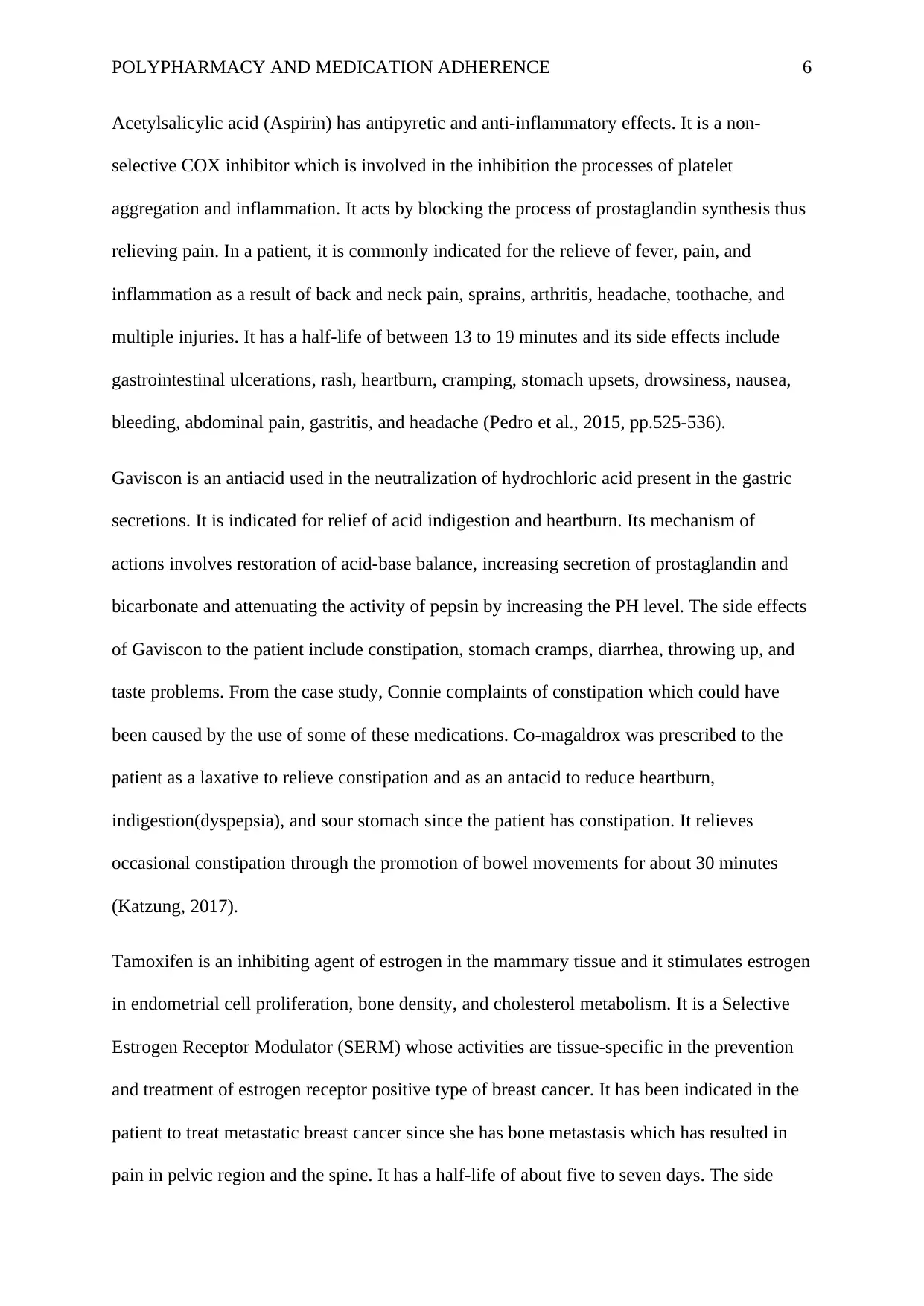
POLYPHARMACY AND MEDICATION ADHERENCE 6
Acetylsalicylic acid (Aspirin) has antipyretic and anti-inflammatory effects. It is a non-
selective COX inhibitor which is involved in the inhibition the processes of platelet
aggregation and inflammation. It acts by blocking the process of prostaglandin synthesis thus
relieving pain. In a patient, it is commonly indicated for the relieve of fever, pain, and
inflammation as a result of back and neck pain, sprains, arthritis, headache, toothache, and
multiple injuries. It has a half-life of between 13 to 19 minutes and its side effects include
gastrointestinal ulcerations, rash, heartburn, cramping, stomach upsets, drowsiness, nausea,
bleeding, abdominal pain, gastritis, and headache (Pedro et al., 2015, pp.525-536).
Gaviscon is an antiacid used in the neutralization of hydrochloric acid present in the gastric
secretions. It is indicated for relief of acid indigestion and heartburn. Its mechanism of
actions involves restoration of acid-base balance, increasing secretion of prostaglandin and
bicarbonate and attenuating the activity of pepsin by increasing the PH level. The side effects
of Gaviscon to the patient include constipation, stomach cramps, diarrhea, throwing up, and
taste problems. From the case study, Connie complaints of constipation which could have
been caused by the use of some of these medications. Co-magaldrox was prescribed to the
patient as a laxative to relieve constipation and as an antacid to reduce heartburn,
indigestion(dyspepsia), and sour stomach since the patient has constipation. It relieves
occasional constipation through the promotion of bowel movements for about 30 minutes
(Katzung, 2017).
Tamoxifen is an inhibiting agent of estrogen in the mammary tissue and it stimulates estrogen
in endometrial cell proliferation, bone density, and cholesterol metabolism. It is a Selective
Estrogen Receptor Modulator (SERM) whose activities are tissue-specific in the prevention
and treatment of estrogen receptor positive type of breast cancer. It has been indicated in the
patient to treat metastatic breast cancer since she has bone metastasis which has resulted in
pain in pelvic region and the spine. It has a half-life of about five to seven days. The side
Acetylsalicylic acid (Aspirin) has antipyretic and anti-inflammatory effects. It is a non-
selective COX inhibitor which is involved in the inhibition the processes of platelet
aggregation and inflammation. It acts by blocking the process of prostaglandin synthesis thus
relieving pain. In a patient, it is commonly indicated for the relieve of fever, pain, and
inflammation as a result of back and neck pain, sprains, arthritis, headache, toothache, and
multiple injuries. It has a half-life of between 13 to 19 minutes and its side effects include
gastrointestinal ulcerations, rash, heartburn, cramping, stomach upsets, drowsiness, nausea,
bleeding, abdominal pain, gastritis, and headache (Pedro et al., 2015, pp.525-536).
Gaviscon is an antiacid used in the neutralization of hydrochloric acid present in the gastric
secretions. It is indicated for relief of acid indigestion and heartburn. Its mechanism of
actions involves restoration of acid-base balance, increasing secretion of prostaglandin and
bicarbonate and attenuating the activity of pepsin by increasing the PH level. The side effects
of Gaviscon to the patient include constipation, stomach cramps, diarrhea, throwing up, and
taste problems. From the case study, Connie complaints of constipation which could have
been caused by the use of some of these medications. Co-magaldrox was prescribed to the
patient as a laxative to relieve constipation and as an antacid to reduce heartburn,
indigestion(dyspepsia), and sour stomach since the patient has constipation. It relieves
occasional constipation through the promotion of bowel movements for about 30 minutes
(Katzung, 2017).
Tamoxifen is an inhibiting agent of estrogen in the mammary tissue and it stimulates estrogen
in endometrial cell proliferation, bone density, and cholesterol metabolism. It is a Selective
Estrogen Receptor Modulator (SERM) whose activities are tissue-specific in the prevention
and treatment of estrogen receptor positive type of breast cancer. It has been indicated in the
patient to treat metastatic breast cancer since she has bone metastasis which has resulted in
pain in pelvic region and the spine. It has a half-life of about five to seven days. The side
⊘ This is a preview!⊘
Do you want full access?
Subscribe today to unlock all pages.

Trusted by 1+ million students worldwide
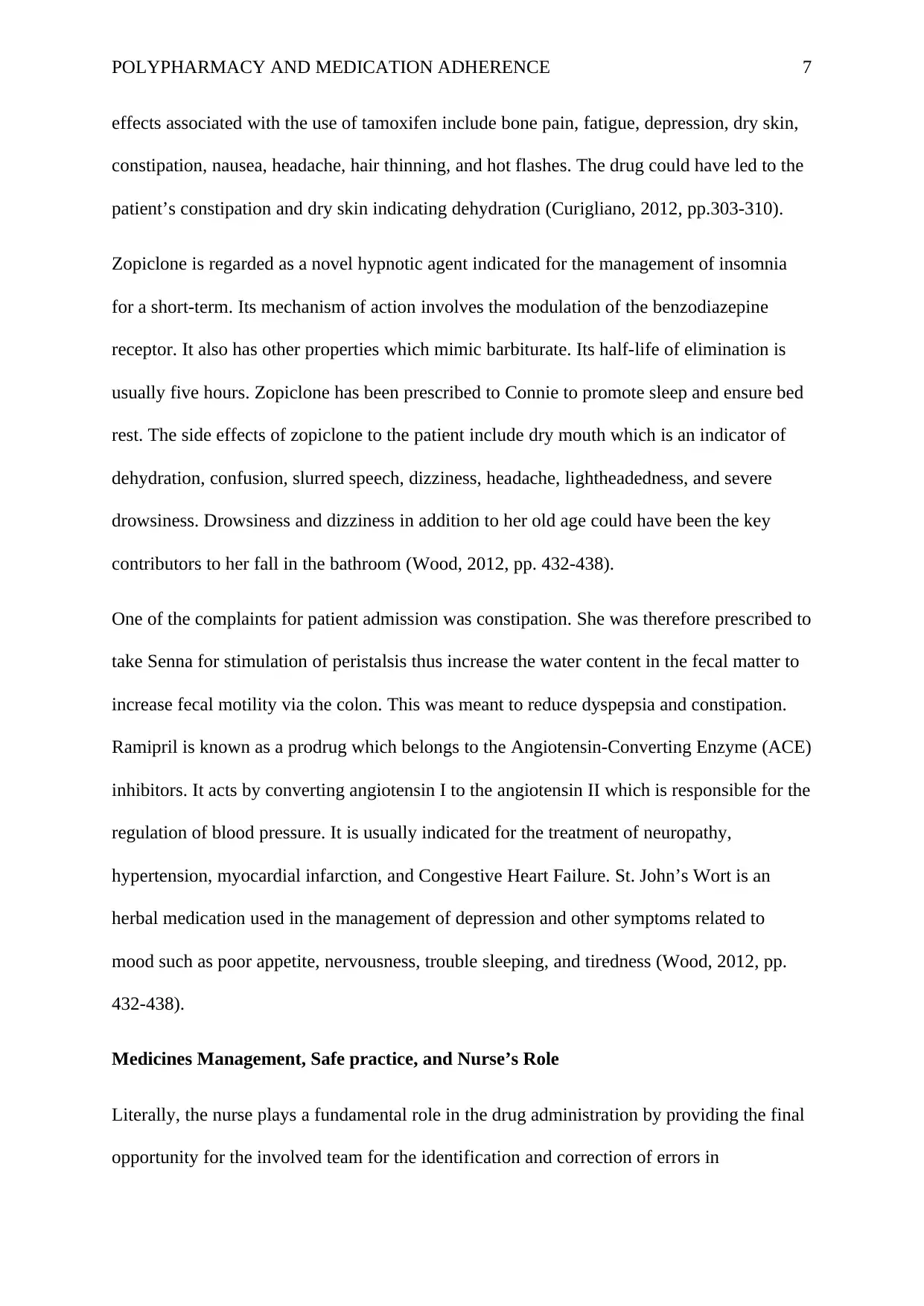
POLYPHARMACY AND MEDICATION ADHERENCE 7
effects associated with the use of tamoxifen include bone pain, fatigue, depression, dry skin,
constipation, nausea, headache, hair thinning, and hot flashes. The drug could have led to the
patient’s constipation and dry skin indicating dehydration (Curigliano, 2012, pp.303-310).
Zopiclone is regarded as a novel hypnotic agent indicated for the management of insomnia
for a short-term. Its mechanism of action involves the modulation of the benzodiazepine
receptor. It also has other properties which mimic barbiturate. Its half-life of elimination is
usually five hours. Zopiclone has been prescribed to Connie to promote sleep and ensure bed
rest. The side effects of zopiclone to the patient include dry mouth which is an indicator of
dehydration, confusion, slurred speech, dizziness, headache, lightheadedness, and severe
drowsiness. Drowsiness and dizziness in addition to her old age could have been the key
contributors to her fall in the bathroom (Wood, 2012, pp. 432-438).
One of the complaints for patient admission was constipation. She was therefore prescribed to
take Senna for stimulation of peristalsis thus increase the water content in the fecal matter to
increase fecal motility via the colon. This was meant to reduce dyspepsia and constipation.
Ramipril is known as a prodrug which belongs to the Angiotensin-Converting Enzyme (ACE)
inhibitors. It acts by converting angiotensin I to the angiotensin II which is responsible for the
regulation of blood pressure. It is usually indicated for the treatment of neuropathy,
hypertension, myocardial infarction, and Congestive Heart Failure. St. John’s Wort is an
herbal medication used in the management of depression and other symptoms related to
mood such as poor appetite, nervousness, trouble sleeping, and tiredness (Wood, 2012, pp.
432-438).
Medicines Management, Safe practice, and Nurse’s Role
Literally, the nurse plays a fundamental role in the drug administration by providing the final
opportunity for the involved team for the identification and correction of errors in
effects associated with the use of tamoxifen include bone pain, fatigue, depression, dry skin,
constipation, nausea, headache, hair thinning, and hot flashes. The drug could have led to the
patient’s constipation and dry skin indicating dehydration (Curigliano, 2012, pp.303-310).
Zopiclone is regarded as a novel hypnotic agent indicated for the management of insomnia
for a short-term. Its mechanism of action involves the modulation of the benzodiazepine
receptor. It also has other properties which mimic barbiturate. Its half-life of elimination is
usually five hours. Zopiclone has been prescribed to Connie to promote sleep and ensure bed
rest. The side effects of zopiclone to the patient include dry mouth which is an indicator of
dehydration, confusion, slurred speech, dizziness, headache, lightheadedness, and severe
drowsiness. Drowsiness and dizziness in addition to her old age could have been the key
contributors to her fall in the bathroom (Wood, 2012, pp. 432-438).
One of the complaints for patient admission was constipation. She was therefore prescribed to
take Senna for stimulation of peristalsis thus increase the water content in the fecal matter to
increase fecal motility via the colon. This was meant to reduce dyspepsia and constipation.
Ramipril is known as a prodrug which belongs to the Angiotensin-Converting Enzyme (ACE)
inhibitors. It acts by converting angiotensin I to the angiotensin II which is responsible for the
regulation of blood pressure. It is usually indicated for the treatment of neuropathy,
hypertension, myocardial infarction, and Congestive Heart Failure. St. John’s Wort is an
herbal medication used in the management of depression and other symptoms related to
mood such as poor appetite, nervousness, trouble sleeping, and tiredness (Wood, 2012, pp.
432-438).
Medicines Management, Safe practice, and Nurse’s Role
Literally, the nurse plays a fundamental role in the drug administration by providing the final
opportunity for the involved team for the identification and correction of errors in
Paraphrase This Document
Need a fresh take? Get an instant paraphrase of this document with our AI Paraphraser
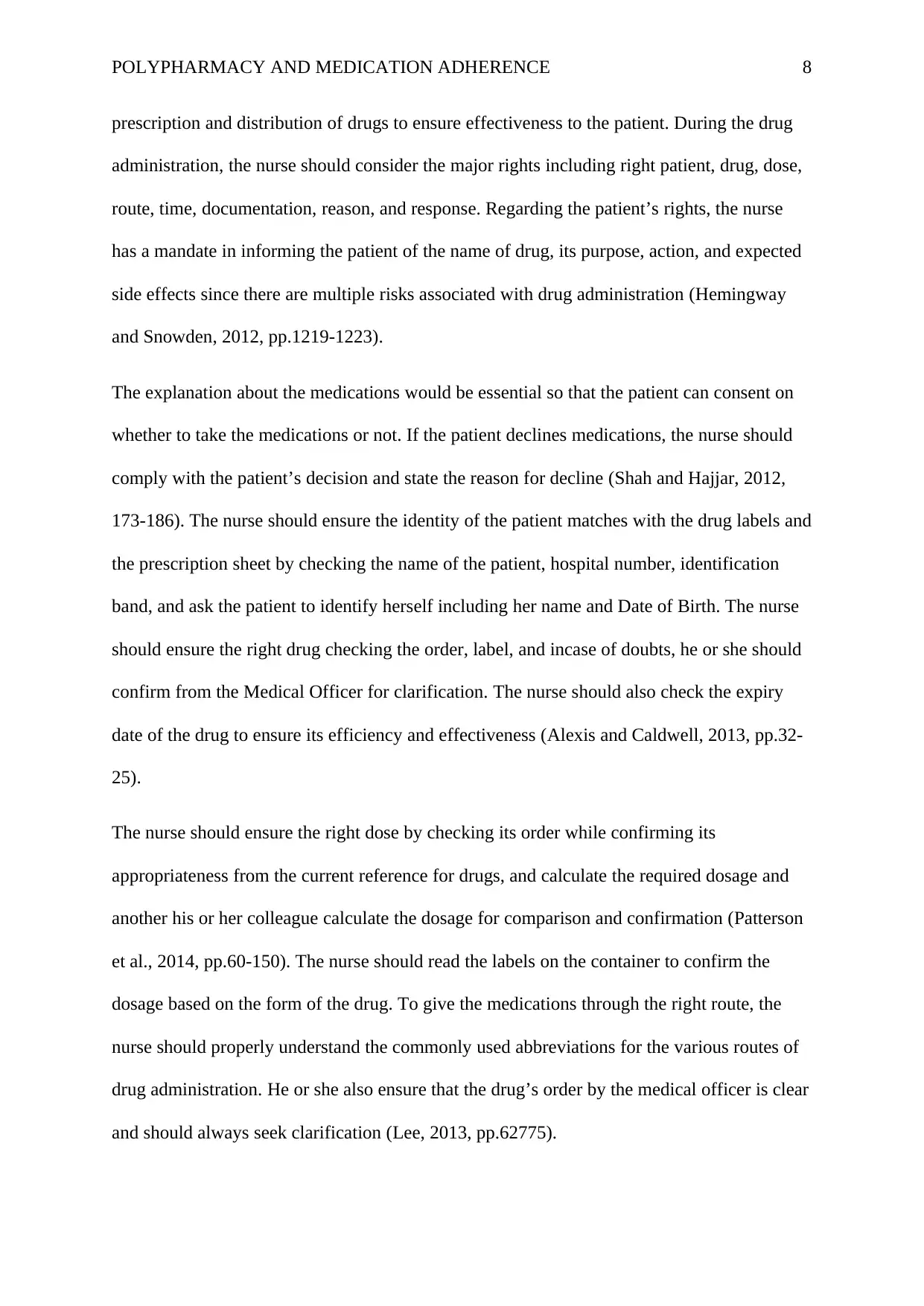
POLYPHARMACY AND MEDICATION ADHERENCE 8
prescription and distribution of drugs to ensure effectiveness to the patient. During the drug
administration, the nurse should consider the major rights including right patient, drug, dose,
route, time, documentation, reason, and response. Regarding the patient’s rights, the nurse
has a mandate in informing the patient of the name of drug, its purpose, action, and expected
side effects since there are multiple risks associated with drug administration (Hemingway
and Snowden, 2012, pp.1219-1223).
The explanation about the medications would be essential so that the patient can consent on
whether to take the medications or not. If the patient declines medications, the nurse should
comply with the patient’s decision and state the reason for decline (Shah and Hajjar, 2012,
173-186). The nurse should ensure the identity of the patient matches with the drug labels and
the prescription sheet by checking the name of the patient, hospital number, identification
band, and ask the patient to identify herself including her name and Date of Birth. The nurse
should ensure the right drug checking the order, label, and incase of doubts, he or she should
confirm from the Medical Officer for clarification. The nurse should also check the expiry
date of the drug to ensure its efficiency and effectiveness (Alexis and Caldwell, 2013, pp.32-
25).
The nurse should ensure the right dose by checking its order while confirming its
appropriateness from the current reference for drugs, and calculate the required dosage and
another his or her colleague calculate the dosage for comparison and confirmation (Patterson
et al., 2014, pp.60-150). The nurse should read the labels on the container to confirm the
dosage based on the form of the drug. To give the medications through the right route, the
nurse should properly understand the commonly used abbreviations for the various routes of
drug administration. He or she also ensure that the drug’s order by the medical officer is clear
and should always seek clarification (Lee, 2013, pp.62775).
prescription and distribution of drugs to ensure effectiveness to the patient. During the drug
administration, the nurse should consider the major rights including right patient, drug, dose,
route, time, documentation, reason, and response. Regarding the patient’s rights, the nurse
has a mandate in informing the patient of the name of drug, its purpose, action, and expected
side effects since there are multiple risks associated with drug administration (Hemingway
and Snowden, 2012, pp.1219-1223).
The explanation about the medications would be essential so that the patient can consent on
whether to take the medications or not. If the patient declines medications, the nurse should
comply with the patient’s decision and state the reason for decline (Shah and Hajjar, 2012,
173-186). The nurse should ensure the identity of the patient matches with the drug labels and
the prescription sheet by checking the name of the patient, hospital number, identification
band, and ask the patient to identify herself including her name and Date of Birth. The nurse
should ensure the right drug checking the order, label, and incase of doubts, he or she should
confirm from the Medical Officer for clarification. The nurse should also check the expiry
date of the drug to ensure its efficiency and effectiveness (Alexis and Caldwell, 2013, pp.32-
25).
The nurse should ensure the right dose by checking its order while confirming its
appropriateness from the current reference for drugs, and calculate the required dosage and
another his or her colleague calculate the dosage for comparison and confirmation (Patterson
et al., 2014, pp.60-150). The nurse should read the labels on the container to confirm the
dosage based on the form of the drug. To give the medications through the right route, the
nurse should properly understand the commonly used abbreviations for the various routes of
drug administration. He or she also ensure that the drug’s order by the medical officer is clear
and should always seek clarification (Lee, 2013, pp.62775).
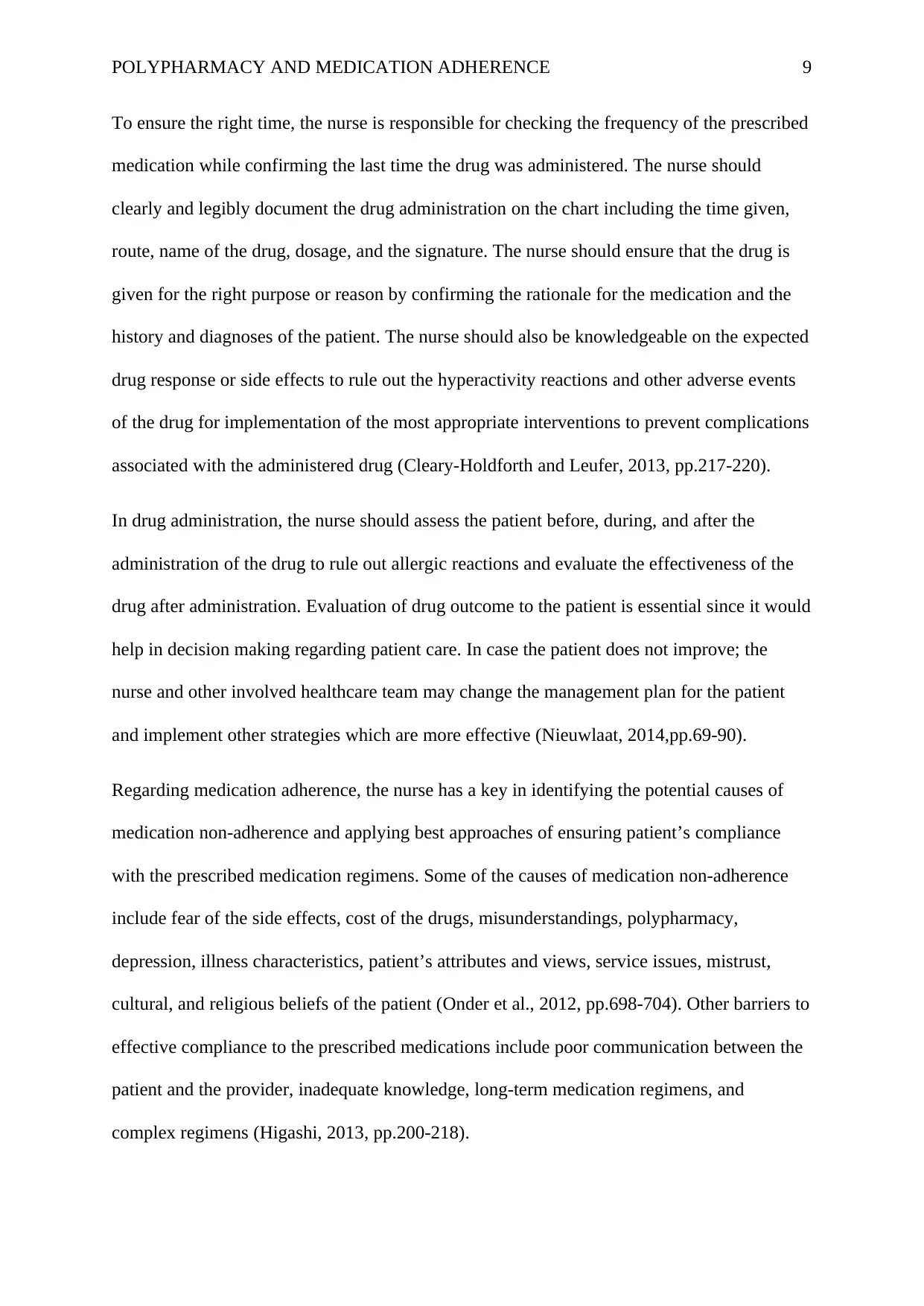
POLYPHARMACY AND MEDICATION ADHERENCE 9
To ensure the right time, the nurse is responsible for checking the frequency of the prescribed
medication while confirming the last time the drug was administered. The nurse should
clearly and legibly document the drug administration on the chart including the time given,
route, name of the drug, dosage, and the signature. The nurse should ensure that the drug is
given for the right purpose or reason by confirming the rationale for the medication and the
history and diagnoses of the patient. The nurse should also be knowledgeable on the expected
drug response or side effects to rule out the hyperactivity reactions and other adverse events
of the drug for implementation of the most appropriate interventions to prevent complications
associated with the administered drug (Cleary-Holdforth and Leufer, 2013, pp.217-220).
In drug administration, the nurse should assess the patient before, during, and after the
administration of the drug to rule out allergic reactions and evaluate the effectiveness of the
drug after administration. Evaluation of drug outcome to the patient is essential since it would
help in decision making regarding patient care. In case the patient does not improve; the
nurse and other involved healthcare team may change the management plan for the patient
and implement other strategies which are more effective (Nieuwlaat, 2014,pp.69-90).
Regarding medication adherence, the nurse has a key in identifying the potential causes of
medication non-adherence and applying best approaches of ensuring patient’s compliance
with the prescribed medication regimens. Some of the causes of medication non-adherence
include fear of the side effects, cost of the drugs, misunderstandings, polypharmacy,
depression, illness characteristics, patient’s attributes and views, service issues, mistrust,
cultural, and religious beliefs of the patient (Onder et al., 2012, pp.698-704). Other barriers to
effective compliance to the prescribed medications include poor communication between the
patient and the provider, inadequate knowledge, long-term medication regimens, and
complex regimens (Higashi, 2013, pp.200-218).
To ensure the right time, the nurse is responsible for checking the frequency of the prescribed
medication while confirming the last time the drug was administered. The nurse should
clearly and legibly document the drug administration on the chart including the time given,
route, name of the drug, dosage, and the signature. The nurse should ensure that the drug is
given for the right purpose or reason by confirming the rationale for the medication and the
history and diagnoses of the patient. The nurse should also be knowledgeable on the expected
drug response or side effects to rule out the hyperactivity reactions and other adverse events
of the drug for implementation of the most appropriate interventions to prevent complications
associated with the administered drug (Cleary-Holdforth and Leufer, 2013, pp.217-220).
In drug administration, the nurse should assess the patient before, during, and after the
administration of the drug to rule out allergic reactions and evaluate the effectiveness of the
drug after administration. Evaluation of drug outcome to the patient is essential since it would
help in decision making regarding patient care. In case the patient does not improve; the
nurse and other involved healthcare team may change the management plan for the patient
and implement other strategies which are more effective (Nieuwlaat, 2014,pp.69-90).
Regarding medication adherence, the nurse has a key in identifying the potential causes of
medication non-adherence and applying best approaches of ensuring patient’s compliance
with the prescribed medication regimens. Some of the causes of medication non-adherence
include fear of the side effects, cost of the drugs, misunderstandings, polypharmacy,
depression, illness characteristics, patient’s attributes and views, service issues, mistrust,
cultural, and religious beliefs of the patient (Onder et al., 2012, pp.698-704). Other barriers to
effective compliance to the prescribed medications include poor communication between the
patient and the provider, inadequate knowledge, long-term medication regimens, and
complex regimens (Higashi, 2013, pp.200-218).
⊘ This is a preview!⊘
Do you want full access?
Subscribe today to unlock all pages.

Trusted by 1+ million students worldwide
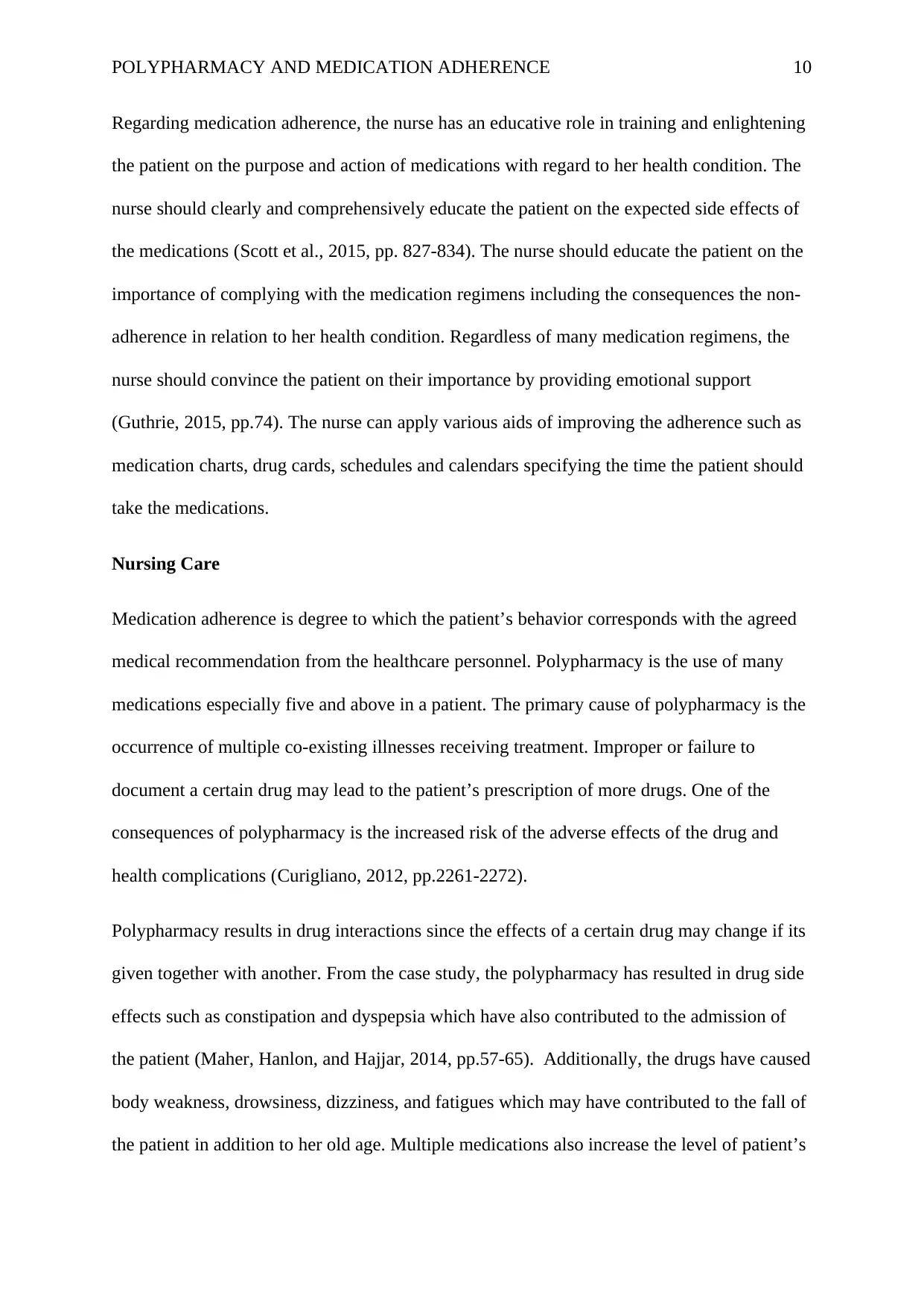
POLYPHARMACY AND MEDICATION ADHERENCE 10
Regarding medication adherence, the nurse has an educative role in training and enlightening
the patient on the purpose and action of medications with regard to her health condition. The
nurse should clearly and comprehensively educate the patient on the expected side effects of
the medications (Scott et al., 2015, pp. 827-834). The nurse should educate the patient on the
importance of complying with the medication regimens including the consequences the non-
adherence in relation to her health condition. Regardless of many medication regimens, the
nurse should convince the patient on their importance by providing emotional support
(Guthrie, 2015, pp.74). The nurse can apply various aids of improving the adherence such as
medication charts, drug cards, schedules and calendars specifying the time the patient should
take the medications.
Nursing Care
Medication adherence is degree to which the patient’s behavior corresponds with the agreed
medical recommendation from the healthcare personnel. Polypharmacy is the use of many
medications especially five and above in a patient. The primary cause of polypharmacy is the
occurrence of multiple co-existing illnesses receiving treatment. Improper or failure to
document a certain drug may lead to the patient’s prescription of more drugs. One of the
consequences of polypharmacy is the increased risk of the adverse effects of the drug and
health complications (Curigliano, 2012, pp.2261-2272).
Polypharmacy results in drug interactions since the effects of a certain drug may change if its
given together with another. From the case study, the polypharmacy has resulted in drug side
effects such as constipation and dyspepsia which have also contributed to the admission of
the patient (Maher, Hanlon, and Hajjar, 2014, pp.57-65). Additionally, the drugs have caused
body weakness, drowsiness, dizziness, and fatigues which may have contributed to the fall of
the patient in addition to her old age. Multiple medications also increase the level of patient’s
Regarding medication adherence, the nurse has an educative role in training and enlightening
the patient on the purpose and action of medications with regard to her health condition. The
nurse should clearly and comprehensively educate the patient on the expected side effects of
the medications (Scott et al., 2015, pp. 827-834). The nurse should educate the patient on the
importance of complying with the medication regimens including the consequences the non-
adherence in relation to her health condition. Regardless of many medication regimens, the
nurse should convince the patient on their importance by providing emotional support
(Guthrie, 2015, pp.74). The nurse can apply various aids of improving the adherence such as
medication charts, drug cards, schedules and calendars specifying the time the patient should
take the medications.
Nursing Care
Medication adherence is degree to which the patient’s behavior corresponds with the agreed
medical recommendation from the healthcare personnel. Polypharmacy is the use of many
medications especially five and above in a patient. The primary cause of polypharmacy is the
occurrence of multiple co-existing illnesses receiving treatment. Improper or failure to
document a certain drug may lead to the patient’s prescription of more drugs. One of the
consequences of polypharmacy is the increased risk of the adverse effects of the drug and
health complications (Curigliano, 2012, pp.2261-2272).
Polypharmacy results in drug interactions since the effects of a certain drug may change if its
given together with another. From the case study, the polypharmacy has resulted in drug side
effects such as constipation and dyspepsia which have also contributed to the admission of
the patient (Maher, Hanlon, and Hajjar, 2014, pp.57-65). Additionally, the drugs have caused
body weakness, drowsiness, dizziness, and fatigues which may have contributed to the fall of
the patient in addition to her old age. Multiple medications also increase the level of patient’s
Paraphrase This Document
Need a fresh take? Get an instant paraphrase of this document with our AI Paraphraser
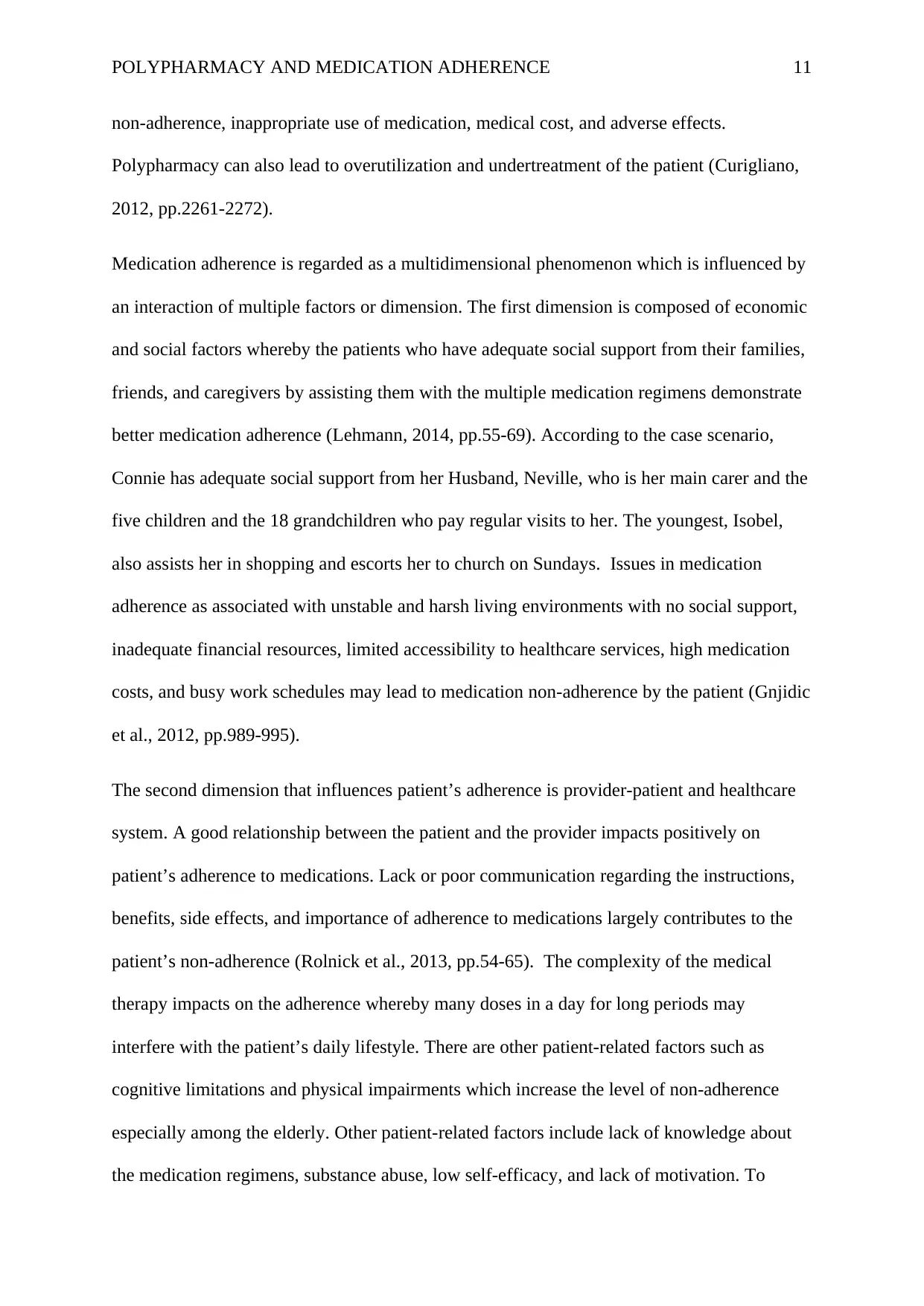
POLYPHARMACY AND MEDICATION ADHERENCE 11
non-adherence, inappropriate use of medication, medical cost, and adverse effects.
Polypharmacy can also lead to overutilization and undertreatment of the patient (Curigliano,
2012, pp.2261-2272).
Medication adherence is regarded as a multidimensional phenomenon which is influenced by
an interaction of multiple factors or dimension. The first dimension is composed of economic
and social factors whereby the patients who have adequate social support from their families,
friends, and caregivers by assisting them with the multiple medication regimens demonstrate
better medication adherence (Lehmann, 2014, pp.55-69). According to the case scenario,
Connie has adequate social support from her Husband, Neville, who is her main carer and the
five children and the 18 grandchildren who pay regular visits to her. The youngest, Isobel,
also assists her in shopping and escorts her to church on Sundays. Issues in medication
adherence as associated with unstable and harsh living environments with no social support,
inadequate financial resources, limited accessibility to healthcare services, high medication
costs, and busy work schedules may lead to medication non-adherence by the patient (Gnjidic
et al., 2012, pp.989-995).
The second dimension that influences patient’s adherence is provider-patient and healthcare
system. A good relationship between the patient and the provider impacts positively on
patient’s adherence to medications. Lack or poor communication regarding the instructions,
benefits, side effects, and importance of adherence to medications largely contributes to the
patient’s non-adherence (Rolnick et al., 2013, pp.54-65). The complexity of the medical
therapy impacts on the adherence whereby many doses in a day for long periods may
interfere with the patient’s daily lifestyle. There are other patient-related factors such as
cognitive limitations and physical impairments which increase the level of non-adherence
especially among the elderly. Other patient-related factors include lack of knowledge about
the medication regimens, substance abuse, low self-efficacy, and lack of motivation. To
non-adherence, inappropriate use of medication, medical cost, and adverse effects.
Polypharmacy can also lead to overutilization and undertreatment of the patient (Curigliano,
2012, pp.2261-2272).
Medication adherence is regarded as a multidimensional phenomenon which is influenced by
an interaction of multiple factors or dimension. The first dimension is composed of economic
and social factors whereby the patients who have adequate social support from their families,
friends, and caregivers by assisting them with the multiple medication regimens demonstrate
better medication adherence (Lehmann, 2014, pp.55-69). According to the case scenario,
Connie has adequate social support from her Husband, Neville, who is her main carer and the
five children and the 18 grandchildren who pay regular visits to her. The youngest, Isobel,
also assists her in shopping and escorts her to church on Sundays. Issues in medication
adherence as associated with unstable and harsh living environments with no social support,
inadequate financial resources, limited accessibility to healthcare services, high medication
costs, and busy work schedules may lead to medication non-adherence by the patient (Gnjidic
et al., 2012, pp.989-995).
The second dimension that influences patient’s adherence is provider-patient and healthcare
system. A good relationship between the patient and the provider impacts positively on
patient’s adherence to medications. Lack or poor communication regarding the instructions,
benefits, side effects, and importance of adherence to medications largely contributes to the
patient’s non-adherence (Rolnick et al., 2013, pp.54-65). The complexity of the medical
therapy impacts on the adherence whereby many doses in a day for long periods may
interfere with the patient’s daily lifestyle. There are other patient-related factors such as
cognitive limitations and physical impairments which increase the level of non-adherence
especially among the elderly. Other patient-related factors include lack of knowledge about
the medication regimens, substance abuse, low self-efficacy, and lack of motivation. To
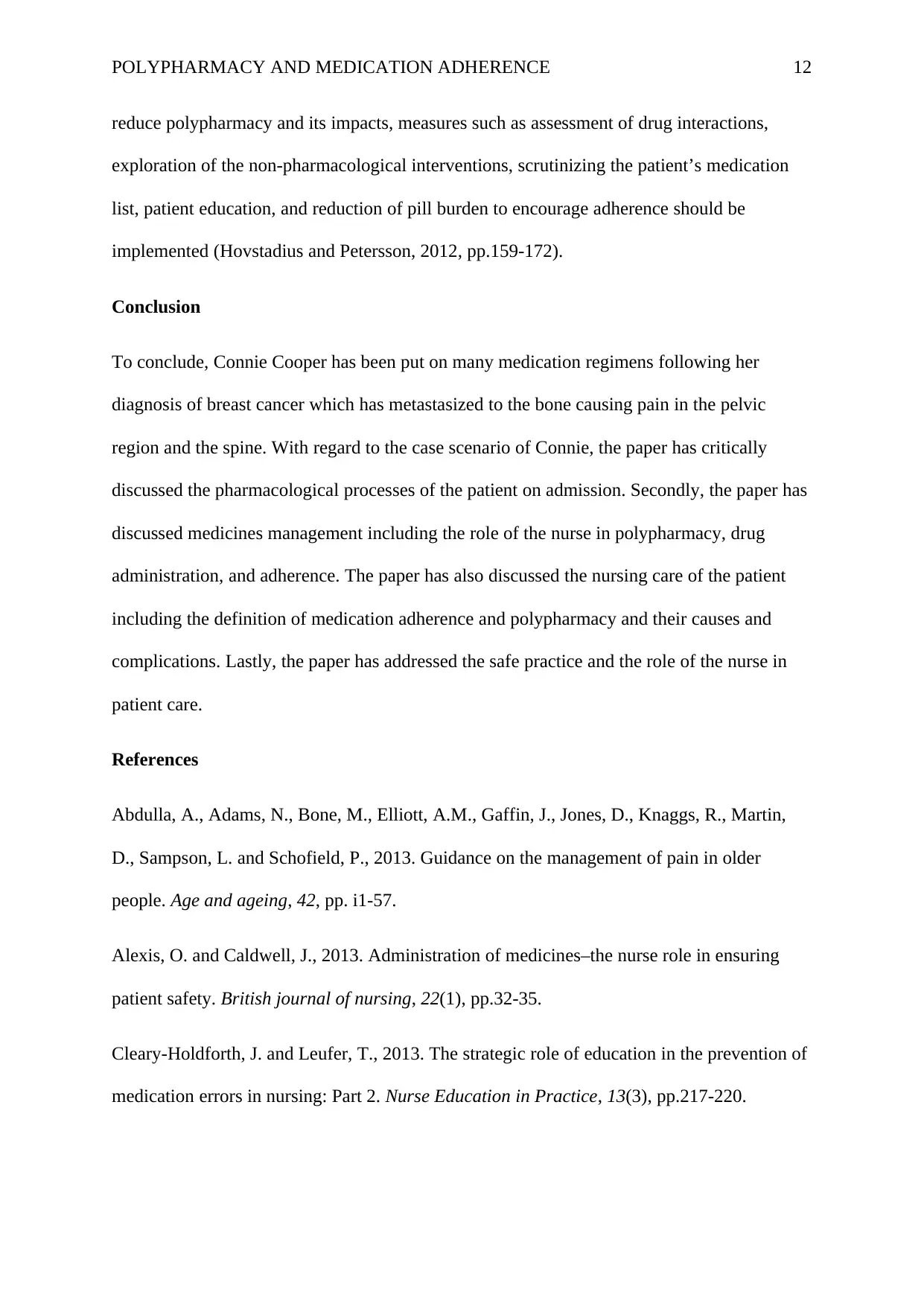
POLYPHARMACY AND MEDICATION ADHERENCE 12
reduce polypharmacy and its impacts, measures such as assessment of drug interactions,
exploration of the non-pharmacological interventions, scrutinizing the patient’s medication
list, patient education, and reduction of pill burden to encourage adherence should be
implemented (Hovstadius and Petersson, 2012, pp.159-172).
Conclusion
To conclude, Connie Cooper has been put on many medication regimens following her
diagnosis of breast cancer which has metastasized to the bone causing pain in the pelvic
region and the spine. With regard to the case scenario of Connie, the paper has critically
discussed the pharmacological processes of the patient on admission. Secondly, the paper has
discussed medicines management including the role of the nurse in polypharmacy, drug
administration, and adherence. The paper has also discussed the nursing care of the patient
including the definition of medication adherence and polypharmacy and their causes and
complications. Lastly, the paper has addressed the safe practice and the role of the nurse in
patient care.
References
Abdulla, A., Adams, N., Bone, M., Elliott, A.M., Gaffin, J., Jones, D., Knaggs, R., Martin,
D., Sampson, L. and Schofield, P., 2013. Guidance on the management of pain in older
people. Age and ageing, 42, pp. i1-57.
Alexis, O. and Caldwell, J., 2013. Administration of medicines–the nurse role in ensuring
patient safety. British journal of nursing, 22(1), pp.32-35.
Cleary-Holdforth, J. and Leufer, T., 2013. The strategic role of education in the prevention of
medication errors in nursing: Part 2. Nurse Education in Practice, 13(3), pp.217-220.
reduce polypharmacy and its impacts, measures such as assessment of drug interactions,
exploration of the non-pharmacological interventions, scrutinizing the patient’s medication
list, patient education, and reduction of pill burden to encourage adherence should be
implemented (Hovstadius and Petersson, 2012, pp.159-172).
Conclusion
To conclude, Connie Cooper has been put on many medication regimens following her
diagnosis of breast cancer which has metastasized to the bone causing pain in the pelvic
region and the spine. With regard to the case scenario of Connie, the paper has critically
discussed the pharmacological processes of the patient on admission. Secondly, the paper has
discussed medicines management including the role of the nurse in polypharmacy, drug
administration, and adherence. The paper has also discussed the nursing care of the patient
including the definition of medication adherence and polypharmacy and their causes and
complications. Lastly, the paper has addressed the safe practice and the role of the nurse in
patient care.
References
Abdulla, A., Adams, N., Bone, M., Elliott, A.M., Gaffin, J., Jones, D., Knaggs, R., Martin,
D., Sampson, L. and Schofield, P., 2013. Guidance on the management of pain in older
people. Age and ageing, 42, pp. i1-57.
Alexis, O. and Caldwell, J., 2013. Administration of medicines–the nurse role in ensuring
patient safety. British journal of nursing, 22(1), pp.32-35.
Cleary-Holdforth, J. and Leufer, T., 2013. The strategic role of education in the prevention of
medication errors in nursing: Part 2. Nurse Education in Practice, 13(3), pp.217-220.
⊘ This is a preview!⊘
Do you want full access?
Subscribe today to unlock all pages.

Trusted by 1+ million students worldwide
1 out of 15
Your All-in-One AI-Powered Toolkit for Academic Success.
+13062052269
info@desklib.com
Available 24*7 on WhatsApp / Email
![[object Object]](/_next/static/media/star-bottom.7253800d.svg)
Unlock your academic potential
Copyright © 2020–2025 A2Z Services. All Rights Reserved. Developed and managed by ZUCOL.
